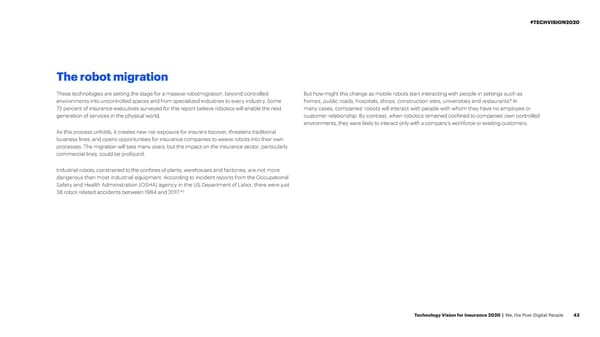#TECHVISION2020 The robot migration These technologies are setting the stage for a massive robotmigration, beyond controlled But how might this change as mobile robots start interacting with people in settings such as environments into uncontrolled spaces and from specialized industries to every industry. Some homes, public roads, hospitals, shops, construction sites, universities and restaurants? In 72 percent of insurance executives surveyed for this report believe robotics will enable the next many cases, companies’ robots will interact with people with whom they have no employee or generation of services in the physical world. customer relationship. By contrast, when robotics remained confined to companies’ own controlled environments, they were likely to interact only with a company’s workforce or existing customers. As this process unfolds, it creates new risk exposure for insurers tocover, threatens traditional business lines, and opens opportunities for insurance companies to weave robots into their own processes. The migration will take many years, but the impact on the insurance sector, particularly commercial lines, could be profound. Industrial robots, constrained to the confines of plants, warehouses and factories, are not more dangerous than most industrial equipment. According to incident reports from the Occupational Safety and Health Administration (OSHA) agency in the US Department of Labor, there were just 43 38 robot-related accidents between 1984 and 2017. Technology Vision for Insurance 2020 | We, the Post-Digital People 43
 Technology Vision for Insurance 2020 Page 42 Page 44
Technology Vision for Insurance 2020 Page 42 Page 44